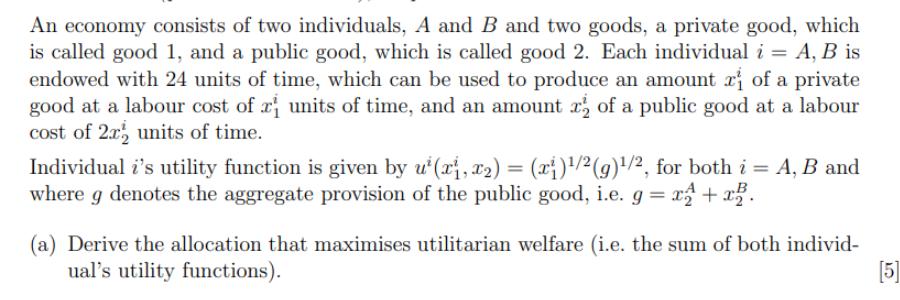Answered step by step
Verified Expert Solution
Question
1 Approved Answer
An economy consists of two individuals, A and B and two goods, a private good, which is called good 1, and a public good,


An economy consists of two individuals, A and B and two goods, a private good, which is called good 1, and a public good, which is called good 2. Each individual i = A, B is endowed with 24 units of time, which can be used to produce an amount of a private good at a labour cost of r units of time, and an amount of a public good at a labour cost of 2x2 units of time. Individual i's utility function is given by u(x, x) = (xi)/2(g)/2, for both i = A, B and where g denotes the aggregate provision of the public good, i.e. g = x + x. (a) Derive the allocation that maximises utilitarian welfare (i.e. the sum of both individ- ual's utility functions). [5] (b) Suppose both individuals decide on provision of feasible bundles (x,x) and (x,x) simultaneously and have full information about the other individual's utility function. Derive the Nash equilibrium of the noncooperative game. (c) Explain concisely (max three sentences) why there is usually under-provision of the public good (you can refer to (i) and (ii), but you can also explain this more generally). (d) Suggest policies that ensure the optimal provision of the public good (max three sentences).
Step by Step Solution
★★★★★
3.32 Rating (152 Votes )
There are 3 Steps involved in it
Step: 1
a Derivation of the allocation that maximizes utilitarian welfare To maximize the sum of both indivi...
Get Instant Access to Expert-Tailored Solutions
See step-by-step solutions with expert insights and AI powered tools for academic success
Step: 2

Step: 3

Ace Your Homework with AI
Get the answers you need in no time with our AI-driven, step-by-step assistance
Get Started


